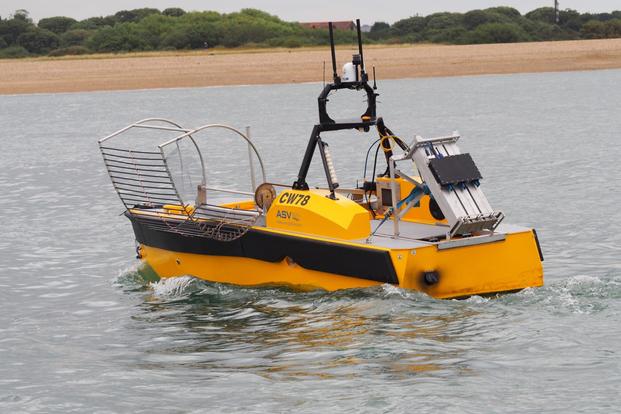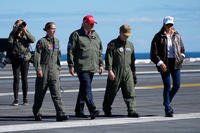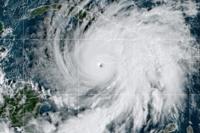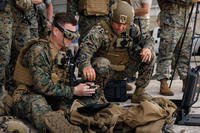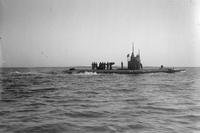NATIONAL HARBOR, Md. -- Industry has responded to the Office of Naval Research's growing interest in unmanned surface vehicles (USVs) for mine detection; hydrographic surveys; and extension of the Navy's intelligence, reconnaissance and surveillance (ISR) reach.
Several firms had both autonomous surface and underwater vehicles on display this week at the Sea-Air-Space exposition at the Gaylord National Convention Center at National Harbor, Maryland.
"It's kind of like a driverless car" that can perform mine and submarine detection as well as hydrographic surveys and reconnaissance at sea, Thomas Chance, chief executive officer of ASV unmanned marine systems, said Monday in front of his firm's 18-foot, 57-horsepower CW-5, or C-Worker, USV model.
"It can do everything pretty much by itself," Chance said of the CW-5. The vessel can be programmed to operate for seven days at up to seven knots off a mothership.
Other ASV models can be programmed to operate autonomously for up to 30 days, he said.
Chance said several European navies are using ASV unmanned boats, and the firm is seeking to bid on U.S. Navy contracts.
Since the early 2000s, the Navy has been experimenting with USVs that would operate autonomously, using algorithms and sensors with only a limited human supervisory role.
"This was a substantial technical challenge because of the harsh dynamics of the sea surface and the potential high density of other maritime traffic," the Office of Naval Research (ONR) said in a release.
In a 2014 test, it was shown that a swarm of USVs could cooperate on escort and attack missions, ONR said.
"Attention is now turning to autonomous control of larger USVs that will have bigger payload capacities, the ability to operate in higher sea states, and much longer ranges," ONR said.
ONR's attention is now focused on a program developed by the Defense Advanced Research Projects Agency that came up with the Anti-Submarine Warfare (ASW) Continuous Trail Unmanned Vessel (ACTUV), called the Sea Hunter.
In January, DARPA turned the Sea Hunter over to ONR, and the transfer marked "a significant milestone in developing large-scale USV technology and autonomy capabilities," said Alexander Wilan, a program manager in DARPA's Tactical Technology Office.
"Our collaboration with ONR has brought closer to reality a future fleet in which both manned warships and capable large unmanned vessels complement each other to accomplish diverse, evolving missions," Wilan said in a DARPA release.
The Sea Hunter, built at a cost of $20 million by Vigor Industrial, is a 132-foot trimaran fitted with two outriggers and two diesel engines capable of producing a top speed of 27 knots, according to DARPA.
-- Richard Sisk can be reached at Richard.Sisk@Military.com.
